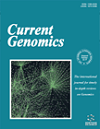- Home
- A-Z Publications
- Current Genomics
- Previous Issues
- Volume 13, Issue 1, 2012
Current Genomics - Volume 13, Issue 1, 2012
Volume 13, Issue 1, 2012
-
-
oa Foreword
More LessThe past year has seen several important developments for Current Genomics. We have achieved a citation index impact factor of 2.48, indicating that the Journal reaches an increasingly wide audience. To achieve a citation index, papers must be formatted by the publisher and submitted for indexing. I want to thank the staff of Bentham Science for their effort in handling these procedures and ensuring the journal reaches a la Read More
-
-
-
oa Editorial [Hot Topic: Replicating Strand Asymmetry in Bacterial and Eukaryotic Genomes (Guest Editor: Feng-Biao Guo)]
More LessIt is my pleasure as a Guest Editor of Current Genomics to present you with a ‘hot topic issue’ on DNA replication. DNA replication adopts a set of asymmetric mechanisms. One of them is the division of leading and lagging strands. In 1991, the nucleotide composition bias between the two replicating strands was originally found in genomes of echinoderm and vertebrate mitochondria. In the following twenty years, more an Read More
-
-
-
Measures of Compositional Strand Bias Related to Replication Machinery and its Applications
More LessAuthors: Kazuharu Arakawa and Masaru TomitaThe compositional asymmetry of complementary bases in nucleotide sequences implies the existence of a mutational or selectional bias in the two strands of the DNA duplex, which is commonly shaped by strand-specific mechanisms in transcription or replication. Such strand bias in genomes, frequently visualized by GC skew graphs, is used for the computational prediction of transcription start sites and replication origins, as w Read More
-
-
-
s DNA Replication and Strand Asymmetry in Prokaryotic and Mitochondrial Genomes
More LessBy Xuhua XiaDifferent patterns of strand asymmetry have been documented in a variety of prokaryotic genomes as well as mitochondrial genomes. Because different replication mechanisms often lead to different patterns of strand asymmetry, much can be learned of replication mechanisms by examining strand asymmetry. Here I summarize the diverse patterns of strand asymmetry among different taxonomic groups to sugges Read More
-
-
-
Replication-Associated Mutational Pressure (RMP) Governs Strand-Biased Compositional Asymmetry (SCA) and Gene Organization in Animal Mitochondrial Genomes
More LessAuthors: Qiang Lin, Peng Cui, Feng Ding, Songnian Hu and Jun YuThe nucleotide composition of the light (L-) and heavy (H-) strands of animal mitochondrial genomes is known to exhibit strand-biased compositional asymmetry (SCA). One of the possibilities is the existence of a replicationassociated mutational pressure (RMP) that may introduce characteristic nucleotide changes among mitochondrial genomes of different animal lineages. Here, we discuss the influence of RMP on Read More
-
-
-
Coding Constraints Modulate Chemically Spontaneous Mutational Replication Gradients in Mitochondrial Genomes
More LessDistances from heavy and light strand replication origins determine duration mitochondrial DNA remains singlestranded during replication. Hydrolytic deaminations from A->G and C->T occur more on single- than doublestranded DNA. Corresponding replicational nucleotide gradients exist across mitochondrial genomes, most at 3rd, least 2nd codon positions. DNA singlestrandedness during RNA transcription causes gr Read More
-
-
-
A Blueprint for a Mutationist Theory of Replicative Strand Asymmetries Formation
More LessAuthors: Vladislav V. Khrustalev and Eugene V. BarkovskyIn the present review, we summarized current knowledge on replicative strand asymmetries in prokaryotic genomes. A cornerstone for the creation of a theory of their formation has been overviewed. According to our recent works, the probability of nonsense mutation caused by replication-associated mutational pressure is higher for genes from lagging strands than for genes from leading strands of both bacteria Read More
-
-
-
Interference Between DNA Replication and Transcription as a Cause of Genomic Instability
More LessAuthors: Yea-Lih Lin and Philippe PaseroReplication and transcription are key aspects of DNA metabolism that take place on the same template and potentially interfere with each other. Conflicts between these two activities include head-on or co-directional collisions between DNA and RNA polymerases, which can lead to the formation of DNA breaks and chromosome rearrangements. To avoid these deleterious consequences and prevent genomic instability, c Read More
-
-
-
Using Genetic Networks and Homology to Understand the Evolution of Phenotypic Traits
More LessAuthors: Amy R. McCune and John C. SchimentiHomology can have different meanings for different kinds of biologists. A phylogenetic view holds that homology, defined by common ancestry, is rigorously identified through phylogenetic analysis. Such homologies are taxic homologies (=synapomorphies). A second interpretation, “biological homology” emphasizes common ancestry through the continuity of genetic information underlying phenotypic traits, and is favored by s Read More
-
Volumes & issues
-
Volume 26 (2025)
-
Volume 25 (2024)
-
Volume 24 (2023)
-
Volume 23 (2022)
-
Volume 22 (2021)
-
Volume 21 (2020)
-
Volume 20 (2019)
-
Volume 19 (2018)
-
Volume 18 (2017)
-
Volume 17 (2016)
-
Volume 16 (2015)
-
Volume 15 (2014)
-
Volume 14 (2013)
-
Volume 13 (2012)
-
Volume 12 (2011)
-
Volume 11 (2010)
-
Volume 10 (2009)
-
Volume 9 (2008)
-
Volume 8 (2007)
-
Volume 7 (2006)
-
Volume 6 (2005)
-
Volume 5 (2004)
-
Volume 4 (2003)
-
Volume 3 (2002)
-
Volume 2 (2001)
-
Volume 1 (2000)
Most Read This Month
Article
content/journals/cg
Journal
10
5
false
en


